The aeroderivative gas turbine service market is projected to grow from USD 5.1 billion in 2025 to USD 8.9 billion by 2035, registering a CAGR of 5.8% during the forecast period. Growth is supported by the increasing demand for flexible and efficient turbine services in power generation, marine propulsion, and oil and gas applications. Refurbishment programs, preventive maintenance contracts, and the adoption of digital monitoring solutions are further contributing to market expansion. Lifecycle extension strategies and compliance with stricter emission norms are expected to accelerate adoption, while the rising deployment of turbines in distributed energy systems enhances long-term demand. By 2035, predictive analytics, parts modernization, and performance optimization solutions will reinforce the importance of aeroderivative turbine services in ensuring operational efficiency, regulatory compliance, and asset reliability.
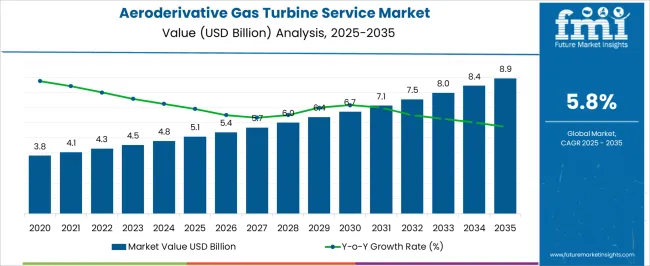
| Metric | Value |
|---|---|
| Aeroderivative Gas Turbine Service Market Estimated Value in (2025 E) | USD 5.1 billion |
| Aeroderivative Gas Turbine Service Market Forecast Value in (2035 F) | USD 8.9 billion |
| Forecast CAGR (2025 to 2035) | 5.8% |
The aeroderivative gas turbine service market is expanding steadily due to the increasing deployment of these turbines in flexible power generation and industrial applications. The rising need for efficient and reliable power supply, particularly in power plants that require quick start-up and load following capabilities, has elevated the demand for aeroderivative turbines and their associated services.
Maintenance and repair services have gained prominence as operators seek to maximize turbine uptime and extend equipment life. Continuous technological advancements in turbine design have led to more complex service requirements, driving growth in specialized service offerings.
Additionally, the trend toward outsourcing maintenance to original equipment manufacturers (OEMs) has been supported by the OEMs’ expertise and ability to provide comprehensive service packages. Regulatory emphasis on operational efficiency and emission control has further encouraged regular servicing. Going forward, the market is expected to grow with increasing investments in power infrastructure and the need for agile turbine operation. Maintenance services, OEM providers, and power plants are expected to lead segment growth.
The aeroderivative gas turbine service market is segmented by service, service provider, application, and geographic region. By service, the market is divided into maintenance, repair, overhaul, and others. By service provider, it is classified into OEM and non-OEM. By application, the market is segmented into power plants, oil & gas, process plants, aviation, marine, and others. Regionally, the aeroderivative gas turbine service market is categorized into North America, Latin America, Western Europe, Eastern Europe, Balkan & Baltic Countries, Russia & Belarus, Central Asia, East Asia, South Asia & Pacific, and the Middle East & Africa.

The Maintenance segment is projected to represent 38.5% of the aeroderivative gas turbine service market revenue in 2025, maintaining its dominance among service types. Maintenance services are critical for ensuring continuous and efficient operation of gas turbines. Regular maintenance helps prevent unexpected breakdowns and costly downtime, which is especially important in power plants where reliability is key.
The segment benefits from increasing turbine installations and the growing complexity of modern equipment that requires specialized attention. Maintenance activities often include inspections, repairs, part replacements, and performance tuning.
As operators aim to extend the lifespan of turbines while optimizing performance, demand for maintenance services is expected to remain strong.

The OEM segment is expected to account for 54.2% of the market revenue in 2025, positioning it as the leading service provider category. OEMs offer deep technical knowledge and access to original parts, making them the preferred choice for many operators seeking high-quality, reliable service.
The trust in OEMs stems from their comprehensive service solutions, ability to address complex repairs, and guarantee of performance standards. Increasing reliance on OEMs also reflects the complexity of newer turbine models that require specialized expertise.
OEMs often provide extended service contracts and digital monitoring services, further enhancing their value proposition. This segment’s growth is fueled by operators’ preference for partnering with original manufacturers to ensure turbine longevity and regulatory compliance.
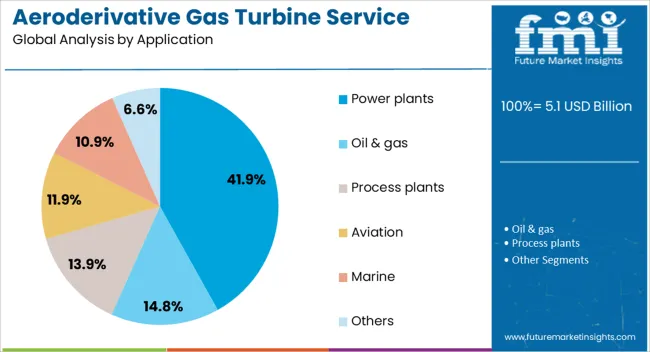
The Power Plants segment is projected to contribute 41.9% of the aeroderivative gas turbine service market revenue in 2025, securing its position as the largest application area. Power plants depend heavily on aeroderivative turbines for their ability to start quickly and operate flexibly in response to grid demands.
The high utilization rates and critical nature of power generation facilities necessitate frequent and high-quality service to avoid operational interruptions. Investment in power generation infrastructure, especially in regions transitioning to cleaner energy sources, has boosted turbine deployment and subsequent service needs.
Power plants also require compliance with stringent emission and efficiency standards, which drives regular maintenance and service activities. Given these factors the power plant sector is expected to continue leading service demand in the aeroderivative gas turbine market.
Aeroderivative gas turbine servicing is expanding due to rising demand for flexible power generation, offshore oil and gas applications, and distributed energy needs. Digital maintenance tools are reshaping operational efficiency and lifecycle management.
Demand for aeroderivative gas turbine services is being driven by the global shift toward flexible, rapid-response power generation. These turbines offer faster start-up times and operational agility compared to heavy-duty alternatives, making them ideal for peaking plants, emergency backup, and grid stability applications. Growth in renewable energy integration has further amplified the need for quick-ramping capacity to balance intermittent generation from wind and solar sources. Service providers are addressing this demand through lifecycle extension programs, performance tuning, and upgrades that enhance load-following capabilities. The ability to support dual-fuel operations also adds operational resilience, especially in regions where fuel supply security is critical for both industrial and utility customers.
The offshore oil and gas sector continues to be a major driver for aeroderivative gas turbine servicing, given their compact size, lighter weight, and high efficiency in mechanical drive operations. These turbines are critical for driving compressors and pumps in offshore platforms, where space and weight constraints make traditional heavy-duty turbines less viable. Increased offshore exploration and production activities, particularly in deepwater projects, are creating steady service demand. Service offerings focus on predictive maintenance, spare parts optimization, and minimizing downtime through rapid deployment of modular service kits. The push for operational efficiency and asset reliability is prompting operators to invest heavily in long-term service agreements.
Digital tools are transforming aeroderivative gas turbine servicing by enabling predictive maintenance and real-time performance tracking. The use of advanced monitoring systems allows early detection of wear, combustion issues, or vibration anomalies, reducing unplanned outages. Service providers are integrating data analytics platforms to model operational behavior and optimize fuel efficiency over the turbine’s lifecycle. Remote monitoring solutions have gained traction, offering faster troubleshooting without on-site intervention. These practices improve turnaround times, reduce service costs, and extend component life. The integration of digital twins for operational simulations is helping operators plan maintenance schedules more effectively, ensuring minimal disruption to power generation or mechanical drive operations.
The rise of distributed power generation has opened new growth avenues for aeroderivative gas turbine servicing, especially in industrial parks, remote communities, and mining operations. These applications require compact, transportable power units that can be rapidly deployed and serviced. Aeroderivative turbines are favored in such settings due to their efficiency, quick installation, and adaptability to varying load demands. Service companies are expanding regional maintenance hubs and developing mobile service units to cater to these decentralized installations. The increasing adoption of modular energy infrastructure worldwide is prompting higher demand for on-site service support, spare part logistics optimization, and multi-fuel operational flexibility.

The aeroderivative gas turbine service market is projected to expand at a global CAGR of 5.8% from 2025 to 2035, driven by rising demand for flexible power generation, offshore oil and gas operations, and distributed energy solutions. China leads with a CAGR of 7.8%, supported by large-scale offshore platform developments, grid balancing needs, and lifecycle extension projects for existing turbine fleets. India follows at 7.3%, fueled by industrial growth, distributed energy adoption, and increased service contracts in refineries and petrochemical plants. France grows at 6.1%, benefiting from modernization of energy infrastructure, increased LNG terminal activity, and a focus on peak-load generation services.
The United Kingdom achieves 5.5% growth, supported by offshore wind integration, oil and gas sector upgrades, and rising service outsourcing to specialized providers. The United States posts a CAGR of 4.9%, reflecting a mature service market where demand is driven by replacement parts, long-term service agreements, and digital maintenance solutions. This analysis incorporates over 40 countries, with these five serving as core benchmarks for strategic planning, regional investment targeting, and competitive positioning in the global aeroderivative gas turbine service market.
China recorded a CAGR near 6.6% during 2020–2024, then the rate is projected at 7.8% in 2025–2035 as peaking plants, offshore platforms, and mobile power fleets expand. Early gains were supported by municipal peaker additions, LNG terminal growth, and overhaul cycles for legacy aero units. The next phase is expected to be shaped by higher runtime on quick-start assets, dual-fuel conversions, and wider use of condition-based maintenance. Spare parts localization has been pursued to shorten outages and stabilize costs. Service consortiums between OEMs and regional utilities have been used to pool inventory and field crews. These steps have increased fleet availability, reduced hot-section turnaround, and raised contract coverage across coastal provinces.
India posted an estimated 6.1% CAGR in 2020–2024, rising to 7.3% for 2025–2035 as industrial parks, refineries, and city gas assets demand fast-ramp power and mechanical drive reliability. Early growth was tied to refinery compressor drives and captive peakers supporting grid constraints. A stronger trajectory is expected from long-term service agreements that bundle hot-section kits, borescope schedules, and remote diagnostics. State tenders for quick-start capacity have improved visibility for parts stocking. Local assembly of sub-systems has been encouraged to manage currency exposure and lead times. Training centers for aero packages have been set up with utilities, which has improved first-time-fix rates and reduced emergency callouts.
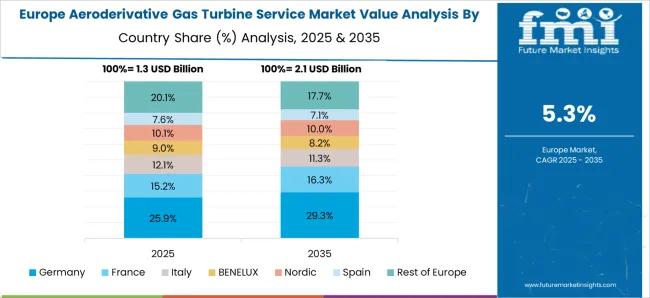
France showed about 5.2% CAGR during 2020–2024, moving to 6.1% in 2025–2035 as LNG regas, district backup plants, and interconnector balancing use more aero capacity. Early activity centered on periodic inspections and combustor life extensions for small peakers. The forward period is expected to add work scopes around low-NOx hardware, fuel flexibility, and fleet digitalization. Parts pooling among operators has been expanded to handle seasonal peaks. Grid operators have prioritized quick-start assets near urban load centers, which raises starts per unit and service demand. Service providers have responded with kit standardization and mobile field teams that reduce site time and shorten restart intervals.
The UK is projected at 5.5% CAGR for 2025–2035. For 2020–2024, a lower pace near 4.7% was estimated since delayed peaker projects, offshore turnarounds, and supply bottlenecks limited service hours. The 2025–2035 rate of 5.5% is stated as broader peaker commissioning, interconnector variability, and offshore maintenance windows increase shop visits and field interventions. The 2020–2024 rate of 4.7% is cited because parts inflation, long lead hot-section kits, and staggered outages suppressed work scopes. The uplift is explained with higher effective starts per unit, improved parts availability from UK hubs, and more comprehensive LTSAs that include performance upgrades and borescope-driven intervals.
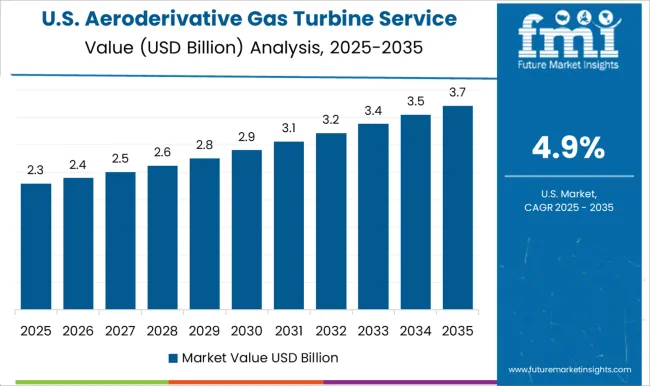
The USA posted about 4.2% CAGR in 2020–2024, stepping to 4.9% for 2025–2035 within a mature base. Earlier activity was concentrated in lifecycle extensions for aging aero fleets and selective upgrades in hurricane-prone regions. A moderate acceleration is expected from capacity payments favoring quick-start units, pipeline compression needs, and reliability programs that tie incentives to availability. Digital monitoring has been adopted to predict combustion wear and bearing issues, which directs planned outages and improves spare staging. Rental aero packages have been used to bridge outages, keeping customer uptime high and driving ancillary service revenue.
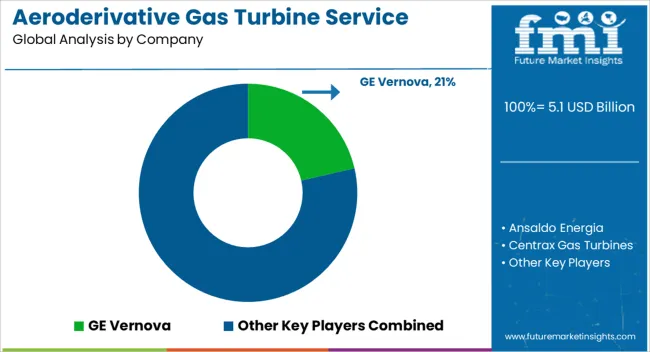
GE Vernova maintains a dominant presence with extensive service networks and proprietary part programs for LM-series turbines. Ansaldo Energia provides life-extension and performance upgrade packages, focusing on fleet optimization. Centrax Gas Turbines specializes in modular service approaches for industrial aeroderivatives, while Destinus Energy targets rapid deployment support for mobile power units.
EthosEnergy offers multi-OEM service capabilities, leveraging global facilities for hot-section and major overhaul work. JSC United Engine supports fleets in Eurasia with OEM-backed part manufacturing and field services. Kawasaki Heavy Industries delivers tailored service programs for mechanical drive aero packages, particularly in LNG and petrochemical sectors. MAN Energy Solutions and Mitsubishi Heavy Industries integrate digital monitoring to enhance predictive maintenance efficiency.
MJB International and MTU Aero Engines focus on independent hot-section expertise, offering flexible service agreements. PROENERGY and RWG are recognized for fast-turnaround field interventions and rotor overhauls. Siemens Energy and Solar Turbines extend lifecycle support with upgrade kits and long-term service agreements. Sulzer provides component repair excellence, TRS SERVICES delivers on-site specialized interventions, and VERICOR supports smaller aero units with tailored maintenance programs.
| Item | Value |
|---|---|
| Quantitative Units | USD Billion |
| Service | Maintenance, Repair, Overhaul, and Others |
| Service Provider | OEM and Non-OEM |
| Application | Power plants, Oil & gas, Process plants, Aviation, Marine, and Others |
| Regions Covered | North America, Europe, Asia-Pacific, Latin America, Middle East & Africa |
| Country Covered | United States, Canada, Germany, France, United Kingdom, China, Japan, India, Brazil, South Africa |
| Key Companies Profiled | GE Vernova, Ansaldo Energia, Centrax Gas Turbines, Destinus Energy, EthosEnergy, JSC United Engine, Kawasaki Heavy Industries, MAN Energy Solutions, Mitsubishi Heavy Industries, MJB International, MTU Aero Engines, PROENERGY, RWG, Siemens Energy, Solar Turbines, Sulzer, TRS SERVICES, and VERICOR |
| Additional Attributes | Dollar sales, share, growth rate by region, competitive landscape, service demand by turbine model, retrofit opportunities, O&M cost trends, regulatory impacts, customer base size, aftermarket revenue potential, contract renewal cycles. |
The global aeroderivative gas turbine service market is estimated to be valued at USD 5.1 billion in 2025.
The market size for the aeroderivative gas turbine service market is projected to reach USD 8.9 billion by 2035.
The aeroderivative gas turbine service market is expected to grow at a 5.8% CAGR between 2025 and 2035.
The key product types in aeroderivative gas turbine service market are maintenance, repair, overhaul and others.
In terms of service provider, oem segment to command 54.2% share in the aeroderivative gas turbine service market in 2025.






Our Research Products

The "Full Research Suite" delivers actionable market intel, deep dives on markets or technologies, so clients act faster, cut risk, and unlock growth.

The Leaderboard benchmarks and ranks top vendors, classifying them as Established Leaders, Leading Challengers, or Disruptors & Challengers.

Locates where complements amplify value and substitutes erode it, forecasting net impact by horizon

We deliver granular, decision-grade intel: market sizing, 5-year forecasts, pricing, adoption, usage, revenue, and operational KPIs—plus competitor tracking, regulation, and value chains—across 60 countries broadly.

Spot the shifts before they hit your P&L. We track inflection points, adoption curves, pricing moves, and ecosystem plays to show where demand is heading, why it is changing, and what to do next across high-growth markets and disruptive tech

Real-time reads of user behavior. We track shifting priorities, perceptions of today’s and next-gen services, and provider experience, then pace how fast tech moves from trial to adoption, blending buyer, consumer, and channel inputs with social signals (#WhySwitch, #UX).

Partner with our analyst team to build a custom report designed around your business priorities. From analysing market trends to assessing competitors or crafting bespoke datasets, we tailor insights to your needs.
Supplier Intelligence
Discovery & Profiling
Capacity & Footprint
Performance & Risk
Compliance & Governance
Commercial Readiness
Who Supplies Whom
Scorecards & Shortlists
Playbooks & Docs
Category Intelligence
Definition & Scope
Demand & Use Cases
Cost Drivers
Market Structure
Supply Chain Map
Trade & Policy
Operating Norms
Deliverables
Buyer Intelligence
Account Basics
Spend & Scope
Procurement Model
Vendor Requirements
Terms & Policies
Entry Strategy
Pain Points & Triggers
Outputs
Pricing Analysis
Benchmarks
Trends
Should-Cost
Indexation
Landed Cost
Commercial Terms
Deliverables
Brand Analysis
Positioning & Value Prop
Share & Presence
Customer Evidence
Go-to-Market
Digital & Reputation
Compliance & Trust
KPIs & Gaps
Outputs
Full Research Suite comprises of:
Market outlook & trends analysis
Interviews & case studies
Strategic recommendations
Vendor profiles & capabilities analysis
5-year forecasts
8 regions and 60+ country-level data splits
Market segment data splits
12 months of continuous data updates
DELIVERED AS:
PDF EXCEL ONLINE
Gas Turbine Service Market Size and Share Forecast Outlook 2025 to 2035
Open Cycle Aeroderivative Gas Turbine Market Size and Share Forecast Outlook 2025 to 2035
Gas Turbine Oil Market Size and Share Forecast Outlook 2025 to 2035
Gas Turbine Market - Size, Share, and Forecast 2025 to 2035
Micro Gas Turbine Market Size and Share Forecast Outlook 2025 to 2035
Steam Turbine Service Market Size and Share Forecast Outlook 2025 to 2035
Aviation Gas Turbines Market
Multifuel Gas Turbine Market Growth – Trends & Forecast 2025 to 2035
Oil and Gas Field Services Market Size and Share Forecast Outlook 2025 to 2035
Heavy Duty Gas Turbine Market Size and Share Forecast Outlook 2025 to 2035
Industrial Gas Turbine Market
Oil And Gas Security And Services Market
Combined Cycle Gas Turbine Market Size and Share Forecast Outlook 2025 to 2035
Process Plants Gas Turbine Market Analysis - Size, Share, and Forecast Outlook 2025 to 2035
Power Generation Gas Turbine Market Size and Share Forecast Outlook 2025 to 2035
Power Plants Heavy Duty Gas Turbine Market Size and Share Forecast Outlook 2025 to 2035
Upstream Oil & Gas Services Market Growth – Trends & Forecast 2022-2032
Gas Insulated Switchgear (GIS) Bushing Market Size and Share Forecast Outlook 2025 to 2035
Gas Discharge Tube (GDT) Arresters Market Size and Share Forecast Outlook 2025 to 2035
Gas & Dual-Fuel Injection Systems Market Size and Share Forecast Outlook 2025 to 2035

Thank you!
You will receive an email from our Business Development Manager. Please be sure to check your SPAM/JUNK folder too.
Chat With
MaRIA